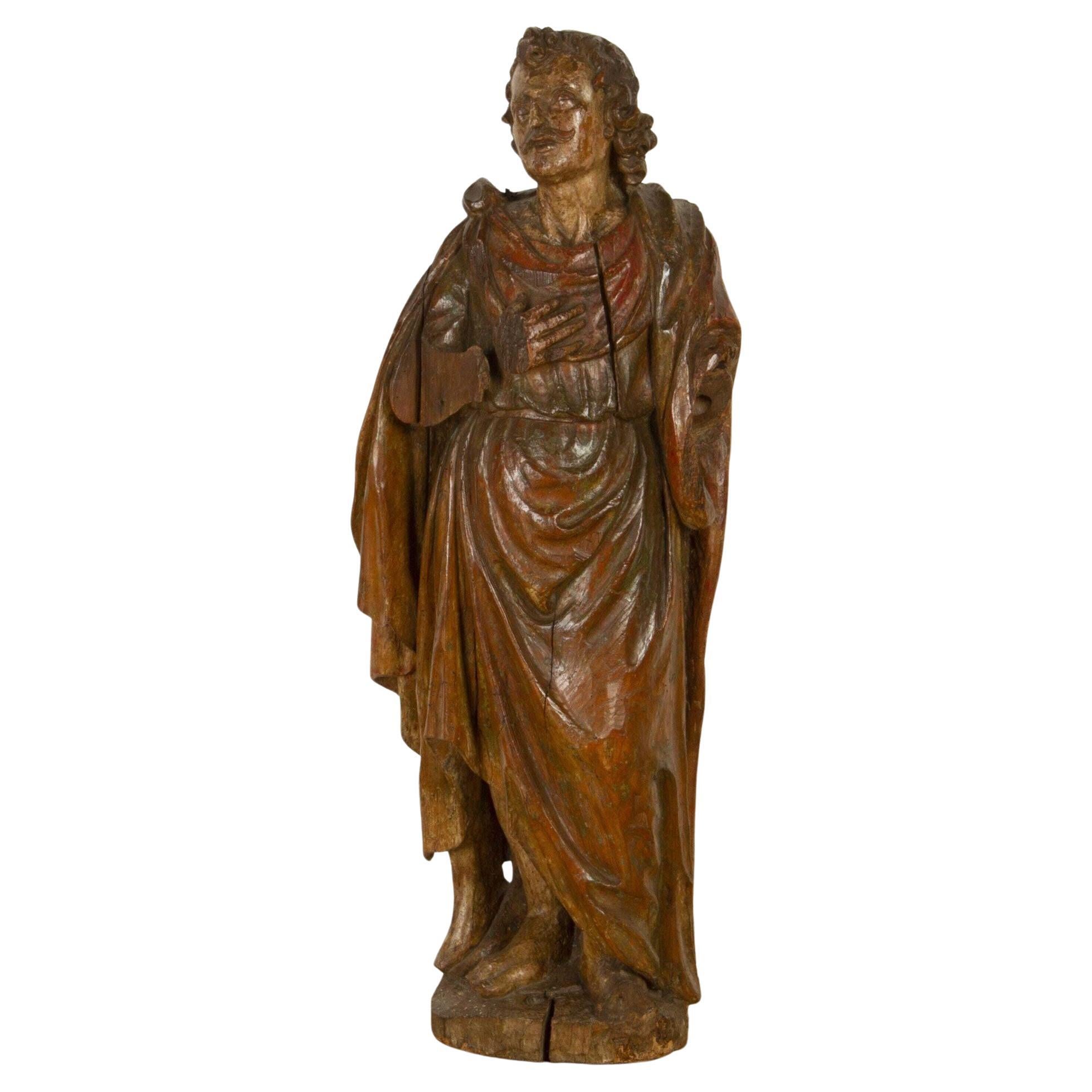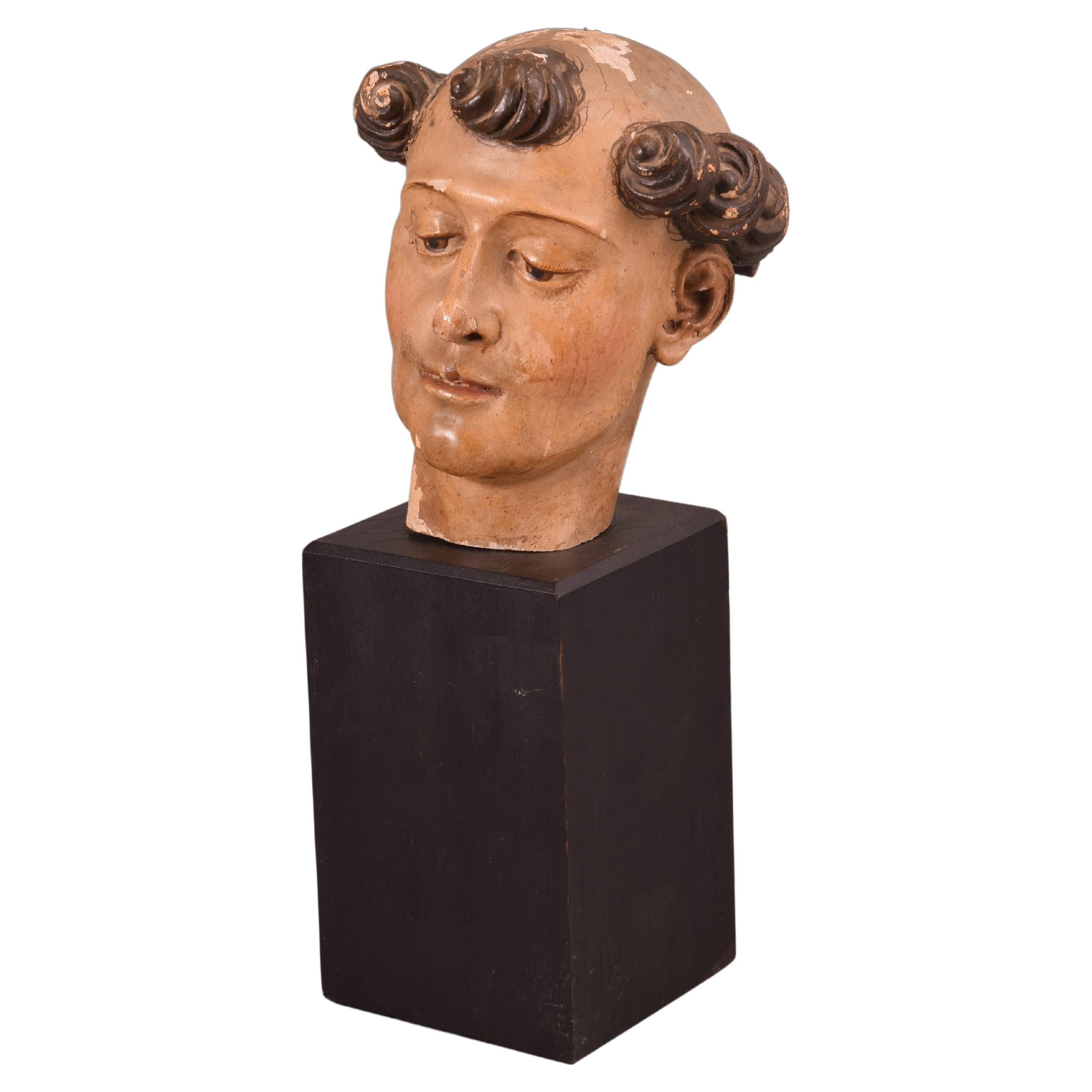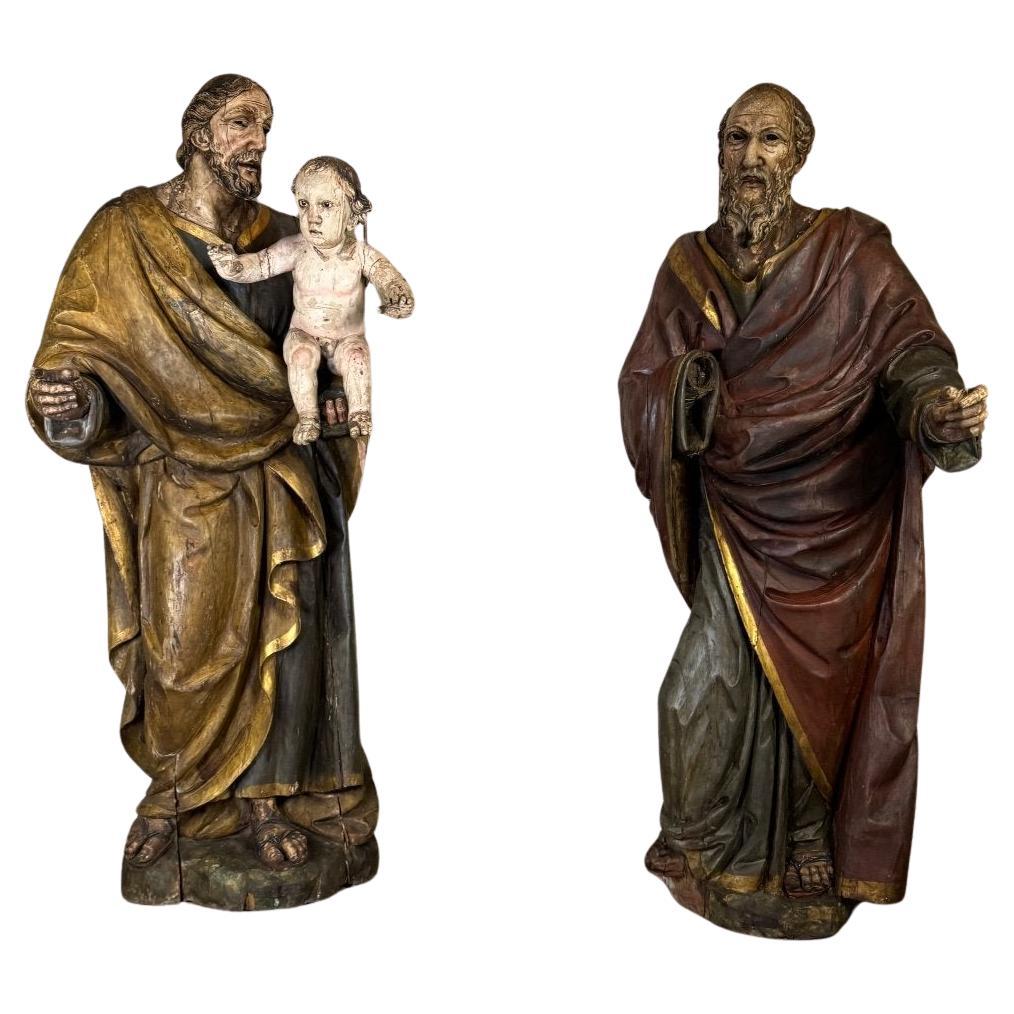Items Similar to Plateau with two breasts, attribute of Saint Agatha - 17th century
Want more images or videos?
Request additional images or videos from the seller
1 of 7
Plateau with two breasts, attribute of Saint Agatha - 17th century
About the Item
Plateau with two breasts, attribute of Saint Agatha
Southern Italy, 17th century
Polychrome and gilded wood
20 x 14,5 x 15 cm
Born into a noble lineage, Agatha came into the world in Catania, Sicily, in the year 231. Endowed with great beauty and deeply devout, she dedicated her life and virginity to God. Quintianus, a consul of low birth, sensual and idolatrous, sought her hand in marriage. Upon her refusal, he had her confined for 30 days in a brothel run by a woman named Aphrodisia, a clear allusion to Aphrodite, the goddess of love and pleasures. Despite threats and promises, Agatha remained steadfast in her vow, rejecting the advances of the consul. Presented once again before him, she refused to worship idols, affirming humbly that, despite her noble lineage, she was but a servant of the Lord.
Enraged, Quintianus ordered her breasts to be twisted and, after prolonged torment, to be torn off before casting her into a dungeon without care or sustenance. In the middle of the night, an elderly man bearing medicines entered the saint's cell and offered to heal her, which she refused, stating that she entrusted such care only to the Lord. The old man then revealed himself to be Saint Peter, one of Christ's apostles, who had come to heal her in His Name. Frightened by the light emanating from the cell, the guards fled, but Agatha refused to escape, unwilling to cause harm to her captors.
A few days later, brought once more before Quintianus, she proclaimed that her healing came from God. The consul then ordered her to be stretched out naked on burning coals, but during this ordeal, an earthquake occurred, which the people attributed to the cruelties inflicted upon Saint Agatha.
Honored since the early Middle Ages, the widespread dissemination of Saint Agatha's relics has been accompanied by an increase in her representations. Early iconographic depictions present the martyr as a young girl richly dressed, without any particular attributes, her name generally inscribed beside her to distinguish her among a procession of other virgins. From the second half of the Middle Ages, scenes of Agatha's torment - the tearing off of her breasts - allow artists to emphasize the terrible aspect of her martyrdom (that is, the saint's suffering for her faith) and to recognize her among a cohort of other saints: the instruments of torture then become the iconographic attributes specific to the saint of Catania, like the tortured parts of her body (her breasts); motifs that have become indispensable in her representations.
The episode of her martyrdom in particular seems to respond to the new post-Tridentine aspirations, as Emile Male rightly pointed out in the first half of the twentieth century: "After the Council of Trent, the martyrs struggle before our eyes; we must see their blood flow, we must witness their painful agony." Certainly, Agatha's horrific torture could only satisfy the requirements of the Counter-Reformation Church
- Dimensions:Height: 5.91 in (15 cm)Width: 7.88 in (20 cm)Depth: 6.3 in (16 cm)
- Style:Baroque (Of the Period)
- Materials and Techniques:
- Place of Origin:
- Period:
- Date of Manufacture:17th century
- Condition:Wear consistent with age and use.
- Seller Location:Bruxelles, BE
- Reference Number:1stDibs: LU6666239114102
About the Seller
5.0
Vetted Seller
These experienced sellers undergo a comprehensive evaluation by our team of in-house experts.
1stDibs seller since 2022
6 sales on 1stDibs
Typical response time: 7 hours
- ShippingRetrieving quote...Ships From: Bruxelles, Belgium
- Return PolicyA return for this item may be initiated within 3 days of delivery.
More From This SellerView All
- Large Cast and Chiseled Bronze Plaque - Saint Sebastian, Rome 17th centuryLocated in Bruxelles, BELarge Cast and Chiseled Bronze Plaque Saint Sebastian after the model by Guido Reni (Capitoline Museum) Rome, 17th century Large rectangular bronze plaque depicting the martyrdom of...Category
Antique 17th Century Italian Baroque Figurative Sculptures
MaterialsBronze
- A Captive Soldier - Italie (Rome), 17th centuryLocated in Bruxelles, BEA Captive Soldier Gilt Bronze, Lost Wax Italie (Rome), 17th century H 17 x Dia 10 cm H 6 2/3 x Dia 4 inch The 17th century witnessed a flourishing of artistic expression across Eur...Category
Antique 17th Century Italian Baroque Figurative Sculptures
MaterialsBronze
- Large Terracotta Relief - Lombardy, First Half of 17th CenturyLocated in Bruxelles, BELarge Terracotta relief of the flight into Egypt Lombardy, first half of 17th century Painted terracotta 91 x 85 x 11,5 cm This event in the early life of Christ is recounted i...Category
Antique 17th Century Italian Baroque Figurative Sculptures
MaterialsTerracotta
- Cerberus, Italy, 17th CenturyLocated in Bruxelles, BECerberus Black painted stone Italy, 17th century Measures: 80 x 69 x 36cm (one head missing) Cerberus, cruel monster, fierce and strange, Through his wide threefold throat barks as a dog Over the multitude immers'd beneath. His eyes glare crimson, black his unctuous beard, His belly large, and claw'd the hands, with which He tears the spirits, flays them, and their limbs Piecemeal disparts (Dante, Inferno, Canto VI). Cerberus figure seated, in his role of ferocious guardian of the underworld; he shows a nervous musculature, an adherent skin which reveals the ribs, long and robust limbs; his heads are broad and the eyes set well apart. Painted in black to amplify his menacing look, the infernal guardian is depicted with his famous attributes, writhing his heads, growling and barking furiously. Cerberus, in Greek mythology, was the monstrous watchdog of the underworld – also known as the “hound of Hades” – preventing the dead from leaving, and making sure that those who entered never left. A child of Typhon and Echidna, he was part of a monstrous family, which included Orthus, the Lernaean Hydra, and the Chimaera as well. Only on three occasions Cerberus was tricked by visitors of Hades: Heracles did it with his strength, Orpheus with his music. In "The Inferno", Dante places Cerberus as the guardian of the third circle of Hell. With his three mouths, Dante saw Cerberus as a beast that was synonymous with the sin of Gluttony. Virgil gets past the monster by throwing mud in his three mouths, temporarily choking him. Very rare are the representations of Cerberus in ancient statuary...Category
Antique 17th Century Italian Renaissance Figurative Sculptures
MaterialsStone
- Adoration of the Magi, Flanders, 17th CenturyLocated in Bruxelles, BEThe Adoration of the Magi. Panel carved in high relief. Flanders, 17th century. Measures: 53 x 32,5 cm.Category
Antique 17th Century Dutch Renaissance Figurative Sculptures
MaterialsWood
- Marble Lion, Périgord, 17th CenturyLocated in Bruxelles, BEMarble lion white marble France, probably Périgord, 17th century Small marble lion wearing a coat of arms pendant with the engraved date, ...Category
Antique 17th Century French Renaissance Animal Sculptures
MaterialsMarble
You May Also Like
- 17th Century Carved Figure of a SaintLocated in Gloucestershire, GBMid 17th century Northern European carved figure of a saint. This striking statue depicts a saint who is dressed in robes, whilst holding his hand over his heart. This figure is freestanding and is stood within a leaning position which makes him stand out. It has been beautifully carved from oak and has remnants of its original paintwork. Likely to have stood within a church for many years and would have been removed due to renovation reasons. This historical figure...Category
Antique 17th Century German Gothic Figurative Sculptures
MaterialsOak, Paint
- Marble Sculpture of a Saint, Late 17th CenturyLocated in CHA late 17th century marble sculpture of a saint, possibly Central Italian. Monogrammed on the marble base "F G F."Category
Antique Late 17th Century Italian Baroque Sculptures
MaterialsMarble
- Spanish Sculpture of Saint Jerome, Late 17th CenturyLocated in CHA late 17th-century Spanish wood sculpture of a penitent Saint Jerome, possibly Seville, circa 1680.Category
Antique 17th Century Spanish Baroque Sculptures
MaterialsWood
- Head of a Saint. Polychromed Wood. 17th Century 'Later Base'By Spanish ManufactoryLocated in Madrid, ESSaint head. Carved and polychrome wood. Spanish school, 17th century. Head made of carved and polychrome wood of a young man, with curly and tonsured dark hair, who keeps his gaze ...Category
Antique 17th Century Spanish Baroque Figurative Sculptures
MaterialsOther
- Saint Francis Xavier Sculpture, 17th Century, Carved WoodLocated in North Miami, FL17th Century Spanish carved oak wood sculpture of Saint Francis Xavier, the co-founder of the society of Jesus.Category
Antique 17th Century Spanish Baroque Figurative Sculptures
MaterialsOak, Wood
- Saint Ambrosius Italian Sculpture 17th CenturyBy Europa AntiquesLocated in Madrid, ESSaint Ambrosius Italian sculpture 17th century in painted and gilded wood. The figure is represented standing up blessing with the hand. Faults and defects. Dimensions. Heigh...Category
Antique Mid-17th Century Italian Gothic Figurative Sculptures
MaterialsWood





